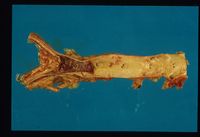Difference between revisions of "Embolism"
Jump to navigation
Jump to search
| (2 intermediate revisions by the same user not shown) | |||
| Line 10: | Line 10: | ||
===Types of Embolism=== | ===Types of Embolism=== | ||
| − | ====Thromboembolism==== | + | ====[[Thromboembolism]]==== |
* These are pieces of thrombi that have broken away from their primary site. | * These are pieces of thrombi that have broken away from their primary site. | ||
| Line 34: | Line 34: | ||
====Tumour emboli==== | ====Tumour emboli==== | ||
| − | + | [[Image:Sarcoma embolus.jpg|thumb|right|200px|<small><center><b>Sarcoma embolus (dog)</b>. Courtesy of T. Scase</center></small>]] | |
* Otherwise known as [[Neoplasia - Pathology#Dissemination of malignant neoplasia|metastasis]]. | * Otherwise known as [[Neoplasia - Pathology#Dissemination of malignant neoplasia|metastasis]]. | ||
* Small groups of tumour cells may break off and be carried in vessels to reach another site | * Small groups of tumour cells may break off and be carried in vessels to reach another site | ||
| Line 108: | Line 108: | ||
=====Lungs===== | =====Lungs===== | ||
| − | * Emboli from the venous system may end up in the [[ | + | * Emboli from the venous system may end up in the [[Pulmonary Embolism, Thrombosis and Infarction|lung]]. |
* The lung has an extensive collateral cirulcation, and so little damage is caused. | * The lung has an extensive collateral cirulcation, and so little damage is caused. | ||
[[Category:Arterial_Pathology]][[Category:Venous_Pathology]] | [[Category:Arterial_Pathology]][[Category:Venous_Pathology]] | ||
| − | [[Category:Circulatory Disorders - Pathology]] | + | [[Category:Circulatory Disorders - Pathology]][[Category:To Do - Cardiovascular]] |
| + | [[Category:Cardiology Section]] | ||
Latest revision as of 15:09, 15 October 2013
Introduction
- An embolus is a detached intravascular mass that is carried by the blood to a site distant from its point of origin.
- May be solid or gaseous.
- Emboli will lodge in a vessel too small to permit further passage.
- Results in occlusion.
Types of Embolism
Thromboembolism
- These are pieces of thrombi that have broken away from their primary site.
- The most common cause of embolism.
Air embolism
- Caused by accidental injection of air from a badly filled hypodermic syringe.
- Small air bubbles may occlude the blood vessels of the brain and cause severe ischaemic necrosis.
Fat embolism
- Pieces of adipose tissue from the bone marrow cavity may enter the blood stream following fracture.
Fibrocartilagenous embolus
- Seen in the dog.
- Thought to arise from a damaged intervertebral disc.
- Cause occlusion of spinal blood vessels.
- Results in:
- Spinal cord necrosis.
- Severe sudden paralysis.
- Results in:
Tumour emboli
- Otherwise known as metastasis.
- Small groups of tumour cells may break off and be carried in vessels to reach another site
in the body.
- May use the lymphatic or blood vessels.
Bacterial emboli
- Some bacteria travel in colonies.
- Come to rest in small capillaries and incite an inflammatory response.
The results of Embolism
- The results of embolism depend on several factors.
- The extent of the occlusion and the availability of an adequate collateral circulation.
- Some emboli may be irregularly shaped, allowing blood to flow around them.
- Duration for which the embolus blocks a vessel.
- Some small thrombi may undergo lysis and quickly disappear.
- Nature of the embolus.
- Bacterial emboli will incite an extensive inflammatory reaction.
- Tumour emboli will multiply and grow into tumour masses.
- The site at which the embolus comes to rest.
- There are two main considerations here.
- The type of tissue supplied.
- The brain and heart are quickly affected by anoxia.
- The type of blood supply to the tissue.
- Occlusion of vessels to a tissue with an end arterial supply will cause ischaemic necrosis or infarction.
- The type of tissue supplied.
- There are two main considerations here.
- The extent of the occlusion and the availability of an adequate collateral circulation.
Ischaemia
- This is the local reduction of blood flow to an area.
- Usually refers to the arterial flow.
- Ischaemia may be partial.
- Results in hypoxia and atrophy of the tissue supplied.
Infarction
- Blockage of an end artery results in acute ischaemic coagulation necrosis, or infarction.
- Some end arteries and their branches are of particluar importance.
- The renal artery.
- The splenic artery.
- The coronary arteries.
- Some cerebral and spinal cord arteries.
- The anterior mesenteric artery.
- There are some areas that have a tendency for infarction.
- The kidneys of pigs and dogs.
- The spleen of the pig.
- The intestine of the horse.
- N.B Infarction of the heart and brain is rare in animals.
Kidney Infarcts
- Typically appear on the cortex.
- Appear as a sharply demarcated pale area surrounded by a red line of haemorrhage.
- A white line of [[Neutrophils - WikiBlood|neutrophils]] forms inside the red line after a few days.
- The necrotic tissue undergoes liquefactive necrosis.
- The area is invaded by fibrous tissue.
- Eventually the lesion ends up as a pale, depressed scar.
- The area is invaded by fibrous tissue.
Splenic infarcts
- Appear red in colour due to haemorrhage into the necrotic area.
- This is an important diagnostic lesion in swine fever.
Intestinal Infarcts
- Small emboli break off followinf thrombosis and occlude intestinal vessels.
- Small intestinal infarcts develop.
- Thought to cause bouts of colic.
- Small intestinal infarcts develop.
- Strongylus vulgaris may also cause intestinal infacts in the horse.
- Lodge at the root of the cranial mesenteric artery.
Lungs
- Emboli from the venous system may end up in the lung.
- The lung has an extensive collateral cirulcation, and so little damage is caused.
